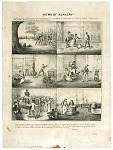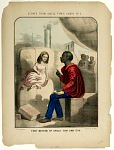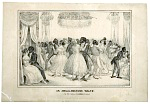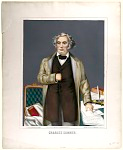unknown
Description
This anti-English political cartoon highlights Northern concerns that Great Britain would abandon its anti-slavery values and instead give support to the Confederacy out of economic interests. In 1862 and 1863, the Northern blockade of the South resulted in a cotton shortage in England, and the textile industry there suffered. In the print, John Bull, the figural representation of Great Britain holds a clump of cotton that he had grasped from a bale. He remarks, “Well yes! it is certain that cotton is more useful to me than wool!!” as he strokes the hair, or “wool,” on the head of a slave kneeling at his feet. Two other black man stand in the back left and proceed to cry. In the back right, a goateed Southern man with a straw hat watches the scene with a joyful look upon his face. Despite Northern anxieties and Southern hopes, Great Britain had little interest in embroiling itself in the American war and maintained a policy of neutrality.Nathaniel Currier (1813-1888) was born in Roxbury, Massachusetts, and after serving an apprenticeship in Boston, he moved to New York City in 1834. In New York, he briefly partnered with Adam Stodart, but their firm dissolved within a year, and Currier went into business on his own until 1857. James M. Ives (1824-1895) was a native New York lithographer who was hired as a bookkeeper by Currier in 1852. In 1857, the two men partnered, forming the famous lithography firm of Currier and Ives, which continued under...
Paper (Overall Material)Ink (Overall Material)
Harry T. Peters "America on Stone" Lithography Collection





















